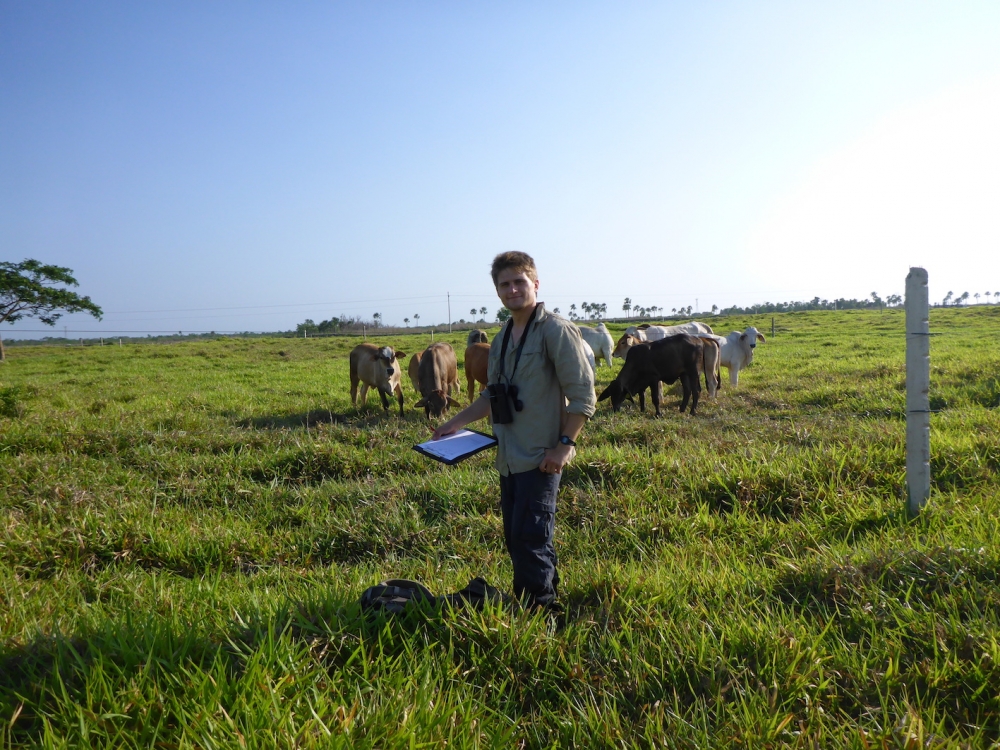
Greener Pastures
When it comes to animal farming, free range isn’t always better. That’s according to a UC Santa Barbara environmental scholar whose research suggests that raising cattle in high densities on designated pastures could be better in the long run — and preserve more natural habitat — than allowing them unfettered access to farmland.
It is a complex concept — using less land while maximizing yield — that David Williams, a postdoctoral scholar in the Bren School of Environmental Science & Management, explores in his paper, “Land-use strategies to balance livestock production, biodiversity conservation and carbon storage in Yucatán, Mexico.” The paper is published in Global Change Biology, a journal that focuses on environmental trends.
“Wildlife-friendly agriculture is obviously good for the environment, but it requires twice as much land,” Williams said, referring to operations that let livestock roam freely in pastures or woods. “Understanding the full impacts of different kinds of food production is quite difficult. And telling people that wildlife-friendly agriculture may be worse for the environment seems extremely counterintuitive.”
“This land-sparing concept is very controversial because many people have invested a lot of time and thought into making agriculture more environmentally friendly,” he added. “Unfortunately, efforts aimed at conserving biodiversity in farmland tend to reduce yields. And that means you’re going to need a larger area to produce the amount of food you want. We have repeatedly found that’s not good for the environment.”
Williams based his research on studying cattle farming in Yucatán, where ranches have expanded into tropical forests — home to jaguars, parrots and other animal and plant species. He noted that farmers and agriculture ministry representatives reacted positively to his approach.
“Everyone was really keen on this because we ended up finding out what was probably best for the environment: Coupling habitat protection and high-yield agriculture is good for everybody,” he said. “Most ranchers would rather have a small, pretty easy-to-manage property with lots and lots of cows on it than a huge rambling ranch where you have no idea where your cows are because they wandered off.”
Far from simple, the concept relies heavily on governments adopting policies that protect natural habitat. These can include subsidies — paying farmers to leave some of their land pristine — similar to the U.S. Department of Agriculture’s Conservation Reserve Program, which allocates $1.7 billion to ranchers and farmers to stop production on wetlands, grasslands and wildlife habitat. The intent is to improve groundwater quality, prevent soil erosion and protect native plants and animals.
Another challenge of “land sparing” is that high-stocking densities might degrade soil of a cattle field faster than normal. Identifying the optimum density would be key to ensure farms are sustainable and to avoid public health issues, including the spread of disease and reduction of air quality.
“We advocate for more concentrated cattle farming because it is less damaging for biodiversity and carbon stocks,” Williams said, “but it has to remain sustainable. It is important to say that we need a better understanding of these potential problems and to know what level of production is sustainable and won’t ruin the soil.”
Acknowledging his research is “quite a few steps” from recommending action, Williams said the aim is to inform policymakers who might push governments to provide incentives for adopting environmentally friendly agriculture.
For now, Williams is committed to promoting a discussion about what a sustainable food system looks like. He has found that proactive “land sparing” is the best strategy for conserving biodiversity — better than wildlife-friendly farming that requires more space — but the potential benefits will depend on which lands are spared and how they are preserved.
Conservation also requires the support of local people, so government policies must be fair and provide benefits — such as increases in yield and income that more than compensate for the cost of imposing restrictions. With forethought, planning and investment, he added, effective conservation programs have the potential to protect biodiversity and increase social acceptance to reduce the food-versus-nature conflict.



